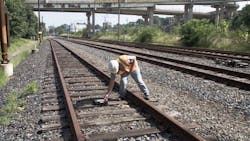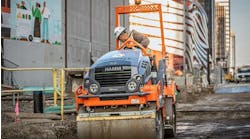Vital Protection During Critical Work
As agencies become more aware of the multiple distractions that can cause human errors, they may look to products and equipment for a solution to enhance safety for maintenance-of-way (MOW) workers.
“Unfortunately, control center personnel, train operators and roadway personnel are encountering more and more visual stimuli and other distractions that may make them vulnerable to failures in executing their primary duties to protect roadway workers,” explained Jaime Maguire, program director of safety solutions, Protran Technology (Protran).
But with the use of proper and updated safety equipment, agencies can continue their efforts in eliminating these incidents safely and efficiently.
Safe location confirmation
Protran offers various types of Roadway Worker Protection (RWP) systems which include a vehicle, wayside and portable option. These serve as a secondary warning system to roadway workers if a train is approaching, giving them enough time to get to safety.
Thanks to technology advancements, these warning systems have evolved from providing localized accuracy and simple notifications to having precision accuracy, creating a more robust system.
“[This] allows for worker tracking, geofencing, ranging technology to calculate the distance to workers and/or to extend or limit signal communications, discernible multiple-train alerts and time-based or distance-based warnings,” Maguire said.
For instance, with a simpler version of Protran’s vehicle-based system, a roadway worker’s personal alert device would issue an audio and visual warning to the train operator but didn’t tell the operator if the worker had made it to safety. Protran’s latest version of its vehicle-based system now provides the operator with additional information before they come into visual contact with the roadway worker.
“The operator is provided [with the] exact distance that they are from the roadway worker on an ‘unconfirmed’ screen, which gives the operator time to start to slow or stop if necessary,” Maguire said. “The roadway worker, once he receives an alert that a train is approaching, is required to move to a place of safety and push a ‘confirm’ button on his personal alert device.”
Protran offers three different types of RWP systems.
The vehicle-based system uses one component for the vehicle and one component for a personal alert device worn by the worker, Maguire says. A warning is provided to the train operator via radio signals that the train is approaching a worker. The worker also receives an audio and visual warning when a train is nearing the work zone.
The wayside-based system also uses a personal alert device and has the other component mounted.
“The wayside-mounted units detect the presence of a train and picks up the location of the roadway worker as the worker moves along the tracks,” Maguire said. “The wayside devices give visual signals to the train operator ahead of the roadway worker. It also detects the passing train and sends a signal to roadway workers ahead that a train is approaching their location.”
The portable system is a bit different utilizing three components, which include a personal alert device, a portable train detector and a portable warning horn and light. Maguire explains the portable system can be placed anywhere along the track or work zone to provide workers enough time to move if a train is detected.
“Transit [agencies] that want both RWP protections and the ability to track the movement of mobile wayside crews would select the ProAccess Wayside Worker Location and RWP System,” Maguire said. “Transit systems that want the operator to have a visual and audible warning that they are approaching a wayside worker or crew would select the vehicle-based Ranging Protracker System. Transits that only want the feature where they are warning wayside workers of approaching trains would select the Portable Protracker System.”
Confidence in real-time train location
In addition to secondary warning systems, train control systems also provide critical safety information for MOW workers. While communications-based train control (CBTC) systems use static RFID tags, wheel odometry and dead-reckoning software to identify a train’s position, Metrom Rail’s CERTIS Train Localization System (CERTIS) incorporates ultrawide-band RF technology (UWB) to provide real-time train positions “down to a resolution of a few inches,” said Rick Carlson, director of business development and corporate strategy, Metrom Rail.
CERTIS utilizes wireless communication with UWB antennas located on the train and a network of UWB Nodes (antennas) that are strategically spaced 600-2,000 feet apart along the wayside.
“The trains utilize ranging data along with onboard track maps to calculate absolute train position many times per second,” Carlson said. “This data is then verified for accuracy and then delivered via vital ethernet protocol into any commercial CBTC system.”
Maguire adds that a benefit of the CERTIS System is all data location processing takes places onboard CERTIS itself. The CBTC system uses the localization data from CERTIS to perform all its current processing responsibilities.
“This greatly simplifies full safety re-certification of integrated solutions, further accelerating modernization efforts of transit agencies,” Carlson said.
CERTIS can also help simplify the train installation of CBTC, since the system doesn’t require odometry and RFID readers. Elements of the CERTIS System includes a UWB antenna and the control module, with the UWB nodes installed in specific locations to create an overlapping and redundant UWB network.
“Currently, it is actually more expensive to install CBTC into a legacy train car, than purchasing a new car which is pre-wired for CBTC,” Carlson said.
Because these systems can be more affordable than traditional CBTC, agencies can install CERTIS on MOW equipment or work trains, adding an extra element of safety for MOW workers.
“The modularity and cost effectiveness of CERTIS allows agencies to install UWB on their MOW or work equipment and integrate directly into the CBTC system,” Carlson said. “The modular design used in CERTIS also introduces additional upgradable capabilities such as UWB-based worker protection, collision avoidance, precision berthing, track intrusion detection and signal compliance.”
A portable and independent safety solution
Another solution to address human error factors when it comes to protecting roadway workers is Miller Ingenuity’s ZoneGuard, an electronic RWP system that detects vehicles entering a work zone through redundant sensor technologies and sends audible and vibrating alarms to workers’ wearable device, explains Christine Nestor, marketing communications specialist, Miller Ingenuity.
“The LIDAR, radar, infrared camera and accelerometer work together to ensure that track vehicles will be detected consistently and accurately,” Nestor said. It’s also helps eliminate the chance of false alerts, that when occurring frequently, can give a false sense of security or wrongfully establish complacency among work crews.”
Compared to older RWP systems, which require the installation of onboard components, ZoneGuard can operate independently from onboard alert units but can be included in the setup if needed. ZoneGuard can also perform across several tracks, over bridges, under high power lines, in loud environments and through curves and tunnels, where older RWP systems can experience trouble in these scenarios, Nestor adds.
Agencies can choose between the fixed or portable ZoneGuard detection system. The portable system takes a few minutes to set up, is durable and lightweight, allowing it to be transported to various job sites. The fixed solution is permanently installed to provide constant train tracking capabilities and can be accessed online at any time by any number of roadway workers.
“The system’s cloud-based web portal can provide customers with real-time worker/work zone information, as well as many key efficiency and safety performance reports to ensure that workers are working in compliance with federal and customer specific safety rules,” Nestor said. “ZoneGuard’s web portal also allows Miller Ingenuity support staff to monitor real-time diagnostics and system performance, collect train detection information logs and provide remote updates to the system for continual system enhancement and quick and seamless system updates.”
Advanced technology brings more flexibility
Whether it’s a permanently installed solution or one that moves jobsite to jobsite, the advancement in technology will continue to evolve the safety features offered in RWP systems and train control systems for MOW workers. Advanced technology can become more flexible, allowing it to be applicable in a variety of applications.
“We are in the development of more accurate signal systems, easier to wear personal alert devices with longer battery life and more rugged portable systems,” Maguire said. “Additionally, we are broadening our focus on [positive train control] and signal system integration to broaden our RWP, suicide prevention and trespassing prevention capabilities.”
Nestor agrees that Millier Ingenuity’s technology allows for flexibility in the evolution of the product, such as applications with pedestrian and trespasser detection, PTC integration and train performance tracking through the system’s web dashboard.
“It is our hope that more and more railroads look into integrating an electronic RWP system into their existing safety procedures,” Nestor concluded. “Using eRWP as a secondary warning system gives workers peace of mind while performing maintenance on the tracks, which increases productivity, and more importantly, allows them to return home safety to their families.”

Megan Perrero | Editor in Chief
Megan Perrero is a national award-winning B2B journalist and lover of all things transit. Currently, she is the Editor in Chief of Mass Transit magazine, where she develops and leads a multi-channel editorial strategy while reporting on the North American public transit industry.
Prior to her position with Mass Transit, Perrero was the senior communications and external relations specialist for the Shared-Use Mobility Center, where she was responsible for helping develop internal/external communications, plan the National Shared Mobility Summit and manage brand strategy and marketing campaigns.
Perrero serves as the board secretary for Latinos In Transit and is a member of the American Public Transportation Association Marketing and Communications Committee. She holds a bachelor’s degree in multimedia journalism with a concentration in magazine writing and a minor in public relations from Columbia College Chicago.


